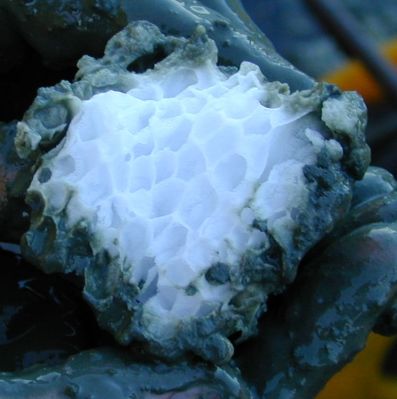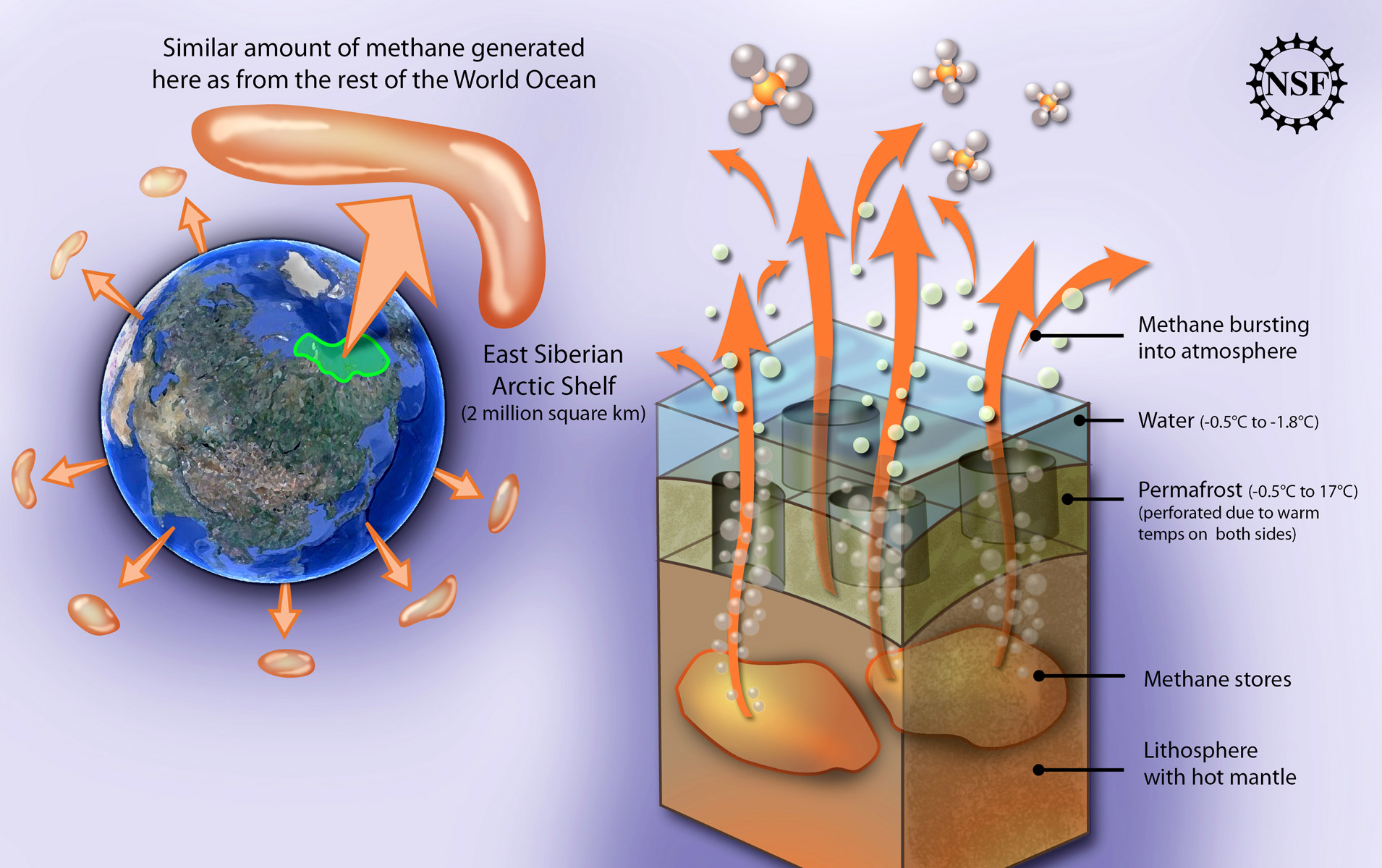As the Earth continues to warm at a worrying rate, scientists continue to work to understand the processes and mechanisms at play. Amidst the myriad of climate-related theories and discussions, the clathrate gun hypothesis stands out not only for its intriguing name but for the profound implications it might have on our understanding of global warming events.
Delving into this hypothesis is akin to reading a detective novel written by Mother Earth, with clues hidden deep beneath the ocean and Arctic ice. It’s a great example of how scientists attempt to predict the future by unpicking the mysteries of the past.
Methane Storage of a Sort

To understand the hypothesis, one must first understand what “clathrate” is. Methane clathrate, as it is formally known, is a type of water ice that contains a great deal of methane trapped within its crystal structure. Residing deep beneath the ocean under the sediments of the seafloor and terrestrial permafrosts, these icy compounds are like nature’s time capsules, storing methane for potentially millions of years.
The core of the Clathrate Gun Hypothesis revolves around a relatively simple idea. As Earth’s temperature rises due to various factors, these ice-like clathrate deposits could become destabilized. This destabilization might lead to the sudden release of significant amounts of methane into the atmosphere. Given that methane is over 25 times more effective at trapping heat than carbon dioxide over a century, such a sudden injection could theoretically lead to rapid spikes in global temperatures.
Geologic records indicate that clathrate-derived methane releases might have played a role in past warming events. It’s suggested that releases of methane from clathrate storage could have helped end a cold period 650 million years ago, commonly referred to as Snowball Earth. Some scientists believe a large methane release from clathrates might have also been a factor in the Paleocene-Eocene Thermal Maximum (PETM). Occurring around 55.5 million years ago, the precise duration of the event is unclear, however it’s believed that global temperatures raised by a massive 5-8 °C after a huge carbon release into the atmosphere over approximately 20,000 to 50,000 years. The overall warm period lasted approximately 200,000 years in total.

Of course, it’s essential to differentiate between the potential and the probable. While there is a vast amount of methane trapped in clathrates, not all of it is vulnerable to release. The clathrates in the deepest parts of the oceans are likely safe due to the intense pressures keeping them stable. It’s the shallower deposits, especially in the Arctic, that are of concern.
Scientists have observed methane plumes rising from the seafloor in some Arctic regions. While alarming, it’s still unclear how much of this is directly due to human-induced climate change or if it’s part of a longer, natural cycle. It’s also important to note that the methane must reach the atmosphere to have a warming effect on the Earth. Current studies suggest that methane from clathrates isn’t getting there just yet.
Recent research involved looking at the isotopic signatures of oceanic methane. Results suggest that while ancient stores of methane are being released from the seafloor, they’re not reaching surface waters. Instead, it appears that the gas is instead dissolving in the water where it may be being broken down by oceanic microbes. These microbes release carbon dioxide, which is both less potent as a greenhouse gas and capable of being stored in other ways in the ocean.
For now, it appears that the clathrate gun is not the leading runaway warming scenario we need to worry about. Regardless, the main challenge lies in predicting future behavior. There’s no doubt that a massive release of clathrate-trapped methane would have dire climatic consequences. However, the timeline and magnitude of such a release remain topics of ongoing research.
The Bigger Picture
The Clathrate Gun Hypothesis provides a vivid illustration of the intricate, interconnected systems that govern our planet’s climate. While it is just one of many factors influencing global temperatures, its potential impact underscores the importance of continued research and monitoring.
Understanding and predicting the behavior of clathrates in a warming world will not only inform climate models but also help humanity prepare for and perhaps mitigate the consequences of rapid climate change events. As always, with scientific exploration, each answer uncovers more questions, and the Clathrate Gun Hypothesis is no exception. Uncovering puzzles like these helps scientists better understand the way our climate works, and how to best focus new research efforts going forward.

















Great article regarding a topic on which I was previously unaware. One might caution you that providing an alternate source of global warming (other than man-made) might be considered heresy by many.
Yrs along with the changing sunspot theory
Yes, along..
I saw it the other way, as an acknowledgement that man made global warming will not produce the doomsday effects on its own, so they have to come up with a sort of doomsday trigger where a small amount of man made global warming somehow produced catastrophe.
This is not trying to explain the global warming observed in past few centuries. Rather, it is a warning of further effects that might happen when the trend continues.
Bourgeoise eschatology
This 👆
This 👆
It’s really describing the potential tipping effect of methane release from clathrates. It doesn’t remotely contradict the consensus on climate science; rather it’s a hot topic of concern, amongst other tipping points, which would amplify already catastrophic projections. The IPCC 6 AR#6 Chapter 5:
“Thawing terrestrial permafrost will lead to carbon release (high confidence), but there is low confidence in the timing, magnitude and the relative roles of CO2 versus CH4 as feedback processes. CO2 release from permafrost is projected to be 3–41 PgC per 1°C of global warming by 2100, based on an ensemble of models. However, the incomplete representation of important processes such as abrupt thaw, combined with weak observational constraints, only allow low confidence in both the magnitude of these estimates and in how linearly proportional this feedback is to the amount of global warming. It is very unlikely that gas clathrates in terrestrial and subsea permafrost will lead to a detectable departure from the emissions trajectory during this century. {5.4.9; Box 5.1}”
Which is consistent with the article (p677).
https://www.ipcc.ch/report/ar6/wg1/downloads/report/IPCC_AR6_WGI_Chapter05.pdf
Consensus, the art of quasi pseudo science.
Humans are the only organism that profoundly alters the climate. This global boiling is unprecedented and we must halt it before it gets worse. Trust the Science. It is undeniable.
Sweet! More climate change hacks, I love these.
The hack is that for only a few thousand dollars you can personally travel to East Siberia and dynamite the clathrates in order to release the mighty INDRA who will sweep the entire world clean and allow the rebirth of a Chakravarti
Couple questions. If methane was trapped in water/ice and was released to end an Ice Age…. How was it released? How was it trapped pre Ice Age?
I was wondering the same thing. If methane caused global warming in the past why didn’t it stay warm and what happened to the methane in the atmosphere?
A CNG powered UFO stopped by to fill up it’s tanks.
Does make me wonder if man made climate change denial will go the same way as denial of holocaust and misogyny. Just as long as denial of existence of aliens stays clean, I’ll be happy.
Cannibal, it isn’t denial so much as skepticism that you can reverse it through government management of allowed technologies. Or that you can reverse it at all. Or that it is a bad thing. And what do you do about the millions who starve to death because you reduced atmospheric CO2? And what……
Easy…. google CYCLE OF METHANE
Large volcano popping up beneath a massive clathrate deposit. Meteor strike on a deposit. Massive earthquake shaking it loose.
Did you now there are methane ice worms? They feed on bacteria which metabolize the methane trapped in the clathrate deposits. https://en.wikipedia.org/wiki/Sirsoe_methanicola
It’s not trapped in water/ice it is the ice. When material decomposes on the ocean floor the methane released is turned into the clathrates due to the temperature/pressure If the temperature increases or the pressure decreases the clathrates sublimate to gas, like nitrogen. That’s my understanding anyway.
I’ve been stumbling across more articles on this in the past few weeks. Hoping it doesn’t happen, but on the trajectory we appear to be on . . . good luck everyone.
No, clathrates are not just frozen methane. It’s methane trapped in water ice.
Natural gas on the ocean floor? Sounds like a fracking opportunity to me!
Clathrates landed on the deck of Deep Water Horizon when the BOP failed. Bad stuff.
Send me all your money, or I will fart again!
One theory for weird things in the “Bermuda Triangle” is methane clathrate eruptions. It takes only a small amount of methane sucked into an airplane or boat engine to make the fuel mix too rich, causing it to stop running. Then the plane falls out of the sky or the boat stops.
Get enough methane released all at once it can foam the water enough to sink a boat. IIRC there are accounts from people about how their boat engine suddenly quit and it couldn’t be restarted, and/or the water suddenly “boiling”. To most people, methane is odorless, and in the low concentration to snuff out the fires in internal combustion engines, it’s too low to cause major breathing problems.
Though methane is flammable adding it to the air intake of an engine already being supplied with the right amount of fuel can create a mixture that has too much fuel and not enough oxygen to burn.
Flying into a plume of methane would make the engine sputter then stop running. If the plume is especially heavy with methane then it could reach the mixture range for combustion in open air. An airplane or boat going into that could find itself enveloped in fire.
Statistically there are no weird things in the Bermuda Triangle, therefore no theory is needed.
Planes can quite happily glide with no engines. They lose altitude sure but it’s not like they just drop out the sky suddenly. They still have radio comms to declare mayday, and even if the methane did knock out the engines, they can be restarted when the air is back to normal. This assumes the pilots managed to don their oxygen masks before being knocked out by the rising sea fart.
In a jet, even volcanoes don’t knock out an engine instantly – and the reason they do eventually is because the ash is both abrasive and builds up in the engines. I can’t imagine how to get enough methane to cruising altitude in one big zone with high enough concentration to even be above the flammability limit much less affect your AFR, but if you did you’d ignite it with your engines I have to assume, which sounds a lot worse than a bit of a rich mixture.
“While we’re discussing hypotheticals that haven’t been tested or even significantly verified…”
Sounds like the Covid vaccine argument all over again. Some people will not be convinced of anything till the entire planet is on fire.
Tossing a Molotov cocktail into the rising plumes will fix that right up. :)
The only way to fix this is govt induced scarcity, govt induced population decline and a rent / lease only 15 minute city lifestyle with 100% taxes. It’s science.
No way back no matter what you do!
Venus here we come….
Follow the money.
Compared to the last article about climate change, I’m glad there are no deniers in here!
There were; the comments have been deleted.